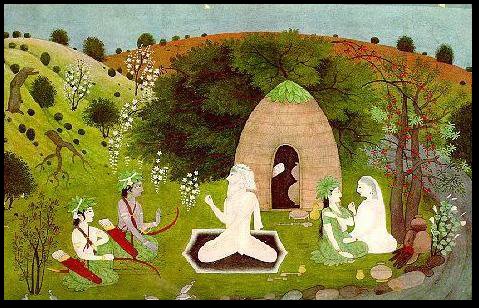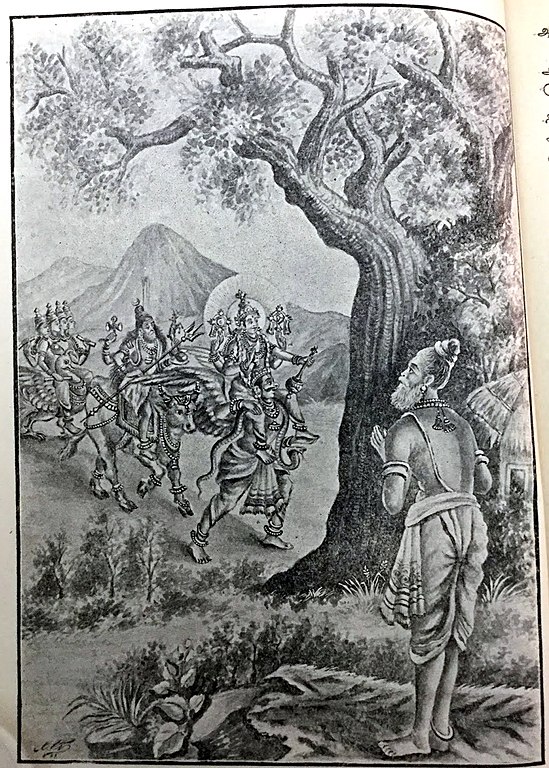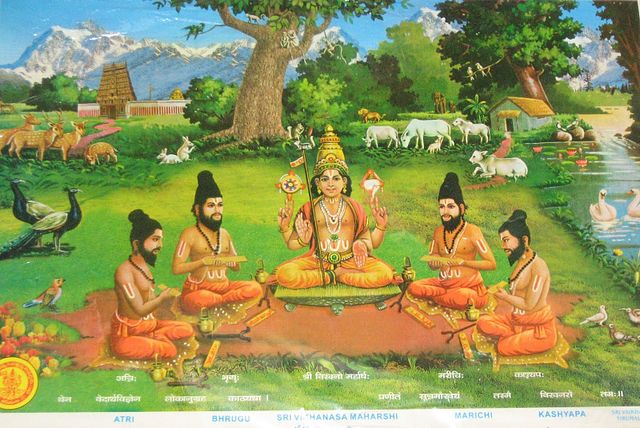
|
ATRI Maharishi
Atri is one of the Manasputra of Brahma and first of the Saptrshis
created by Bramha.
Ram visiting Atri's hermitage. As Atri talks to Ram and his brother Lakshman, Anusuya talks with his wife Sita
Affiliation : Brahmarshi
Atri or Attri is a Vedic sage, who is credited with composing numerous hymns to Agni, Indra and other Vedic deities of Hinduism. Atri is one of the Saptarishi (seven great Vedic sages) in the Hindu tradition, and the one most mentioned in its scripture Rigved.
The fifth Mandal (Book 5) of Rigved is called the Atri Mandal in his honour, and the eighty seven hymns in it are attributed to him and his descendants.
Atri is also mentioned in the Purans and the Hindu Epics such as the Ramayan and the Mahabharat.
Life :
Mahavishnu and the Brahma Rudras appear in front of Saint Atri
Atri is one of the seven great Rishi or Saptarshi along with Marichi, Angiras, Pulah, Kratu, Pulastya and Vashisth. According to the legends of the Vedic era, sage Atri was married to Anasuya Devi. They had three sons, Dattatreya, Durvasas and Chandra. As per divine account, he is the last among the seven saptharishis and is believed to have originated from the tongue. The wife of Atri was Anasuya, who is considered one of the seven female pativratas. When instructed by divine voice to do penance, Atri readily agreed and did severe penance. Pleased by his devotion and prayers, the Hindu trinity, namely, Brahma, Vishnu and Shiv appeared before him and offered him boons. He sought all the three to be born to him. Another version of the legend states that Anasuya, by the powers of her chastity, rescued the three gods and in return, they were born as children to her. Brahma was born to her as Chandra, Vishnu as Dattatreya and Shiv in some part as Durvasa. The mention about Atri is found in various scriptures, with the notable being in Rig Ved. He is also associated with various ages, the notable being in Treta Yug during Ramayan, when he and Anasuya advised Ram and his wife Sita. The pair is also attributed to bringing river Ganga down to earth, the mention of which is found in Shiv Puran.
Seer
of Rig Ved :
The Atri hymns of the Rigved are significant for their melodic structure as well as for featuring spiritual ideas in the form of riddles. These hymns include lexical, syntactic, morphological and verb play utilizing the flexibility of the Sanskrit language. The hymn 5.44 of the Rigved in Atri Mandal is considered by scholars such as Geldner to be the most difficult riddle hymn in all of the Rigved. The verses are also known for their elegant presentation of natural phenomenon through metaphors, such as poetically presenting dawn as a cheerful woman in hymn 5.80.
While the fifth mandal is attributed to Atri and his associates, sage Atri is mentioned or credited with numerous other verses of the Rigved in other Mandals, such as 10.137.4.
Ramayan
:
Purans
:
Cultural influence :
Left to right : Atri, Bhrigu, Vikhanas, Marichi and Kashyap
The Vaikhanas sub-tradition within Vaishnavism found in South India near Tirupati, credit their theology to four Rishis (sages), namely Atri, Marici, Bhrigu and Kashyap. One of the ancient texts of this tradition is Atri Samhita, which survives in highly inconsistent fragments of manuscripts. The text are rules of conduct aimed at Brahmins of the Vaikhanas tradition. The surviving parts of the Atri Samhita suggest that the text discussed, among other things, Yog and ethics of living, with precepts such as :
Self
restraint :
Source :
https://en.wikipedia.org/ |


